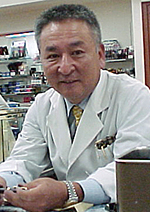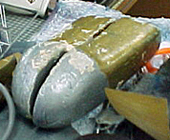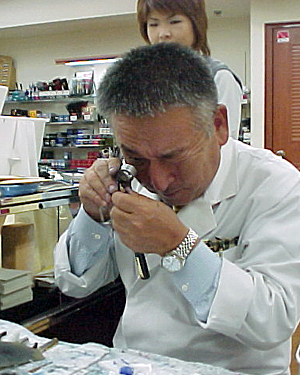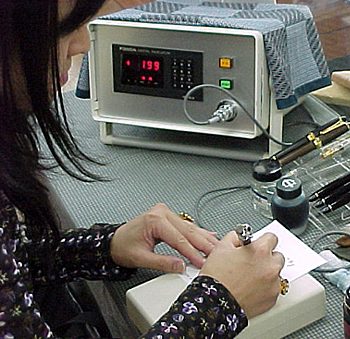Sailor's Pen Doctor, Mr. Kawaguchi
October, 2002
 Thanks to the Chicago and Washington pen shows, pen lovers in the west have discovered Sailor's nib master, Mr. Nagahara. Well, Sailor actually has two nib masters. One has stayed in Japan to keep up Sailor's grueling schedule of pen clinics for the benefit of Japanese pen lovers. His name is Mr. Kawaguchi, and on his business card is the title "Pen Doctor." Thanks to the Chicago and Washington pen shows, pen lovers in the west have discovered Sailor's nib master, Mr. Nagahara. Well, Sailor actually has two nib masters. One has stayed in Japan to keep up Sailor's grueling schedule of pen clinics for the benefit of Japanese pen lovers. His name is Mr. Kawaguchi, and on his business card is the title "Pen Doctor."
 I had the opportunity to meet Mr. Kawaguchi at a Sailor Pen clinic at Maruzen department store in Nihonbashi. His table was covered with an assortment of tools and pens, and in the midst of them was a large wooden model of the tip of a pen nib, painted to indicate the gold nib and silver colored tipping. It is constructed in two parts to show the relationship of the tines to each other. He uses this to explain to customers with sick pens what the problem is, and how he intends to fix it.
I had the opportunity to meet Mr. Kawaguchi at a Sailor Pen clinic at Maruzen department store in Nihonbashi. His table was covered with an assortment of tools and pens, and in the midst of them was a large wooden model of the tip of a pen nib, painted to indicate the gold nib and silver colored tipping. It is constructed in two parts to show the relationship of the tines to each other. He uses this to explain to customers with sick pens what the problem is, and how he intends to fix it.
Nearly every weekend, all year around, Sailor sends either Mr. Nagahara or Mr. Kawaguchi to its pen clinics held at locations throughout Japan. Mr. Kawaguchi has personally repaired several thousands of fountain pens on the spot at some 40 different locations--at no charge to the customers. He said that nearly everyone who comes to him with a problem pen, comes for the same reason; ink won't come out. And 80 percent of these are fixed by simply adjusting the part of the nib which is depicted in the wooden model. Unfortunately, when one's pen stops writing, the natural tendency is to press harder, and this causes further damage!
 When a customer brings a fountain pen to the pen clinic, Mr. Kawaguchi asks a few questions about its history and after some initial adjustments, closely observes how the owner holds and writes with the pen. This gives him a good indication of what caused the pen to stop writing in the first place. He is then able to make further adjustments to allow the pen to not only write well, but to write well in that particular person's hand. The whole procedure takes from 2 to 8 minutes. At the time of this interview late in the afternoon, he had already fixed some 50 pens for about 25 people (many brought in more than one pen). He also fixes pens that are mailed to him at the Sailor offices, but without the benefit of personal observation of the owner actually using the pen, these repairs can take up to 30 minutes.
When a customer brings a fountain pen to the pen clinic, Mr. Kawaguchi asks a few questions about its history and after some initial adjustments, closely observes how the owner holds and writes with the pen. This gives him a good indication of what caused the pen to stop writing in the first place. He is then able to make further adjustments to allow the pen to not only write well, but to write well in that particular person's hand. The whole procedure takes from 2 to 8 minutes. At the time of this interview late in the afternoon, he had already fixed some 50 pens for about 25 people (many brought in more than one pen). He also fixes pens that are mailed to him at the Sailor offices, but without the benefit of personal observation of the owner actually using the pen, these repairs can take up to 30 minutes.
As we talked, Mr. Kawaguchi launched into a lecture on "mosaikan" or "capillary action." (I must confess that since it was all in Japanese, and fairly technical, a lot of it went over my head.) This capillary action is the principal behind most of the pen problems he encounters, and he has devoted much time to its study. He has made calculations based on such factors as nib and feed materials and sizes, and internal and external pressure, and has determined that for the best ink flow, the distance between the ink source (the near end of the cartridge in modern pens) and the tip of the nib ought to be 29 milimeters. Sailor's Profit series fountain pens in particular have been built according to these findings.
 Then Mr. Kawaguchi turned my attention to a low flat box with a metal plate on the top of it. He placed a piece of paper on the plate and asked me to write a certain kanji character with my fountain pen. As I did, the number 178 appeared on a monitor next to the box. This was my writing pressure, which he said was relatively light. He then had me write the same character with a ball point pen. The number shot up to 276! The same test with a mechanical pencil gave a 256. Then Mr. Kawaguchi turned my attention to a low flat box with a metal plate on the top of it. He placed a piece of paper on the plate and asked me to write a certain kanji character with my fountain pen. As I did, the number 178 appeared on a monitor next to the box. This was my writing pressure, which he said was relatively light. He then had me write the same character with a ball point pen. The number shot up to 276! The same test with a mechanical pencil gave a 256.
He told me that 5 percent of Japanese fountain pen users write with pressure of 150 or below, and the best nibs for these people are EF or F. A whopping 80 percent have writing pressure between 150 and 250, and these people are best off with FM or M nibs. Because of this high percentage of people, limited edition pens made in Japan are fitted with M nibs. The remaining 15 percent write with pressure above 250, and are encouraged to use B or BB nibs. If a first time fountain pen buyer is in the medium nib category but insists on buying a fine nib, there is a good chance that the pen will come back to Mr. Kawaguchi for repairs. Experienced fountain pen users are an exception since they are more sensitive to a nib's limitations. That was good news for me since I prefer EF nibs!
 I then watched as a man brought to Mr. Kawaguchi a steel nib Rotring fountain pen that no longer wrote. He looked at it in his loupe and informed the man that the tines had separated, demonstrating the problem on his wooden model. He then wrapped the nib in a small rubber sheet, and effortlessly yanked it out of the section as my jaw dropped. He then performed a variety of quick tasks such as inserting a feeler guage between the tines, grinding the tip on abrasive material, and squeezing the sides of the nib with needle nose pliers. He then gave the pen back to the man and watched closely as he wrote his name and address. He then took the pen back and made more adjustments until the pen wrote perfectly to the customer's joy. The whole process took less than 5 minutes.
I then watched as a man brought to Mr. Kawaguchi a steel nib Rotring fountain pen that no longer wrote. He looked at it in his loupe and informed the man that the tines had separated, demonstrating the problem on his wooden model. He then wrapped the nib in a small rubber sheet, and effortlessly yanked it out of the section as my jaw dropped. He then performed a variety of quick tasks such as inserting a feeler guage between the tines, grinding the tip on abrasive material, and squeezing the sides of the nib with needle nose pliers. He then gave the pen back to the man and watched closely as he wrote his name and address. He then took the pen back and made more adjustments until the pen wrote perfectly to the customer's joy. The whole process took less than 5 minutes.
Over the years many customers have brought in their one and only fountain pens, their precious treasures which had been used so much over so many years that the tipping had worn off and they were writing with the gold nib itself. These present their own particular challenges, but Mr. Kawaguchi finds the concept of owning one good pen for a lifetime as very appealing. He handed me his own favorite lifetime pen, and let me try it out. It was a beautiful Sailor pen whose briar barrel had darkened considerably over many years of use. As one would expect, the pen doctor's pen wrote like a dream.
Russ Stutler
|